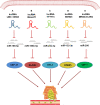The Emerging Landscape of Long Non-Coding RNAs in Colorectal Cancer Metastasis
- PMID: 33718238
- PMCID: PMC7947863
- DOI: 10.3389/fonc.2021.641343
The Emerging Landscape of Long Non-Coding RNAs in Colorectal Cancer Metastasis
Abstract
Colorectal cancer (CRC) is one of the most common gastrointestinal cancers, with extremely high rates of morbidity and mortality. The main cause of death in CRC is distant metastasis; it affects patient prognosis and survival and is one of the key challenges in the treatment of CRC. Long non-coding RNAs (lncRNAs) are a group of non-coding RNA molecules with more than 200 nucleotides. Abnormal lncRNA expression is closely related to the occurrence and progression of several diseases, including cancer. Recent studies have shown that numerous lncRNAs play pivotal roles in the CRC metastasis, and reversing the expression of these lncRNAs through artificial means can reduce the malignant phenotype of metastatic CRC to some extent. This review summarizes the major mechanisms of lncRNAs in CRC metastasis and proposes lncRNAs as potential therapeutic targets for CRC and molecular markers for early diagnosis.
Keywords: cancer metastasis; colorectal cancer; lncRNAs; markers; signaling pathways; therapy.
Copyright © 2021 Liao, Nie, Wang, Luo, Zhou and Ou.
Conflict of interest statement
The authors declare that the research was conducted in the absence of any commercial or financial relationships that could be construed as a potential conflict of interest. The reviewer QL declared a shared affiliation, with no collaboration, with several of the authors ZL, HN, YW, JZ, CO to the handling editor at the time of the review.
Figures


Similar articles
-
The functions of long non-coding RNAs in colorectal cancer.Transl Cancer Res. 2019 Sep;8(5):2192-2204. doi: 10.21037/tcr.2019.08.23. Transl Cancer Res. 2019. PMID: 35116969 Free PMC article. Review.
-
Involvement of Non-coding RNAs in the Signaling Pathways of Colorectal Cancer.Adv Exp Med Biol. 2016;937:19-51. doi: 10.1007/978-3-319-42059-2_2. Adv Exp Med Biol. 2016. PMID: 27573893 Review.
-
Roles of long noncoding RNAs in colorectal cancer metastasis.Oncotarget. 2017 Jun 13;8(24):39859-39876. doi: 10.18632/oncotarget.16339. Oncotarget. 2017. PMID: 28418892 Free PMC article. Review.
-
Emerging Roles of lncRNAs in the Formation and Progression of Colorectal Cancer.Front Oncol. 2020 Jan 17;9:1542. doi: 10.3389/fonc.2019.01542. eCollection 2019. Front Oncol. 2020. PMID: 32010629 Free PMC article. Review.
-
Long non-coding RNAs in colorectal cancer.Oncotarget. 2016 Feb 2;7(5):5226-39. doi: 10.18632/oncotarget.6446. Oncotarget. 2016. PMID: 26637808 Free PMC article. Review.
Cited by
-
Epithelial-mesenchymal transition-related long noncoding RNAs in gastric carcinoma.Front Mol Biosci. 2022 Oct 12;9:977280. doi: 10.3389/fmolb.2022.977280. eCollection 2022. Front Mol Biosci. 2022. PMID: 36310592 Free PMC article. Review.
-
Long non-coding RNA FENDRR inhibits the stemenss of colorectal cancer cells through directly binding to Sox2 RNA.Bioengineered. 2021 Dec;12(1):8698-8708. doi: 10.1080/21655979.2021.1977054. Bioengineered. 2021. PMID: 34697986 Free PMC article.
-
Emerging role of ferroptosis-related circular RNA in tumor metastasis.Front Pharmacol. 2023 Apr 24;14:1168458. doi: 10.3389/fphar.2023.1168458. eCollection 2023. Front Pharmacol. 2023. PMID: 37168995 Free PMC article. Review.
-
Effects of the lncRNA ENST00000623984 on colon cancer and the biological characteristics of colon cancer cells.Eur J Histochem. 2021 Jul 12;65(3):3215. doi: 10.4081/ejh.2021.3215. Eur J Histochem. 2021. PMID: 34247468 Free PMC article.
-
The role of long non-coding RNA FGD5-AS1 in cancer.Bioengineered. 2022 Apr;13(4):11026-11041. doi: 10.1080/21655979.2022.2067292. Bioengineered. 2022. PMID: 35475392 Free PMC article. Review.
References
-
- Hughes LAE, Simons C, van den Brandt PA, van Engeland M, Weijenberg MP. Lifestyle, Diet, and Colorectal Cancer Risk According to (Epi)genetic Instability: Current Evidence and Future Directions of Molecular Pathological Epidemiology. Curr Colorectal Cancer Rep (2017) 13(6):455–69. 10.1007/s11888-017-0395-0 - DOI - PMC - PubMed
Publication types
LinkOut - more resources
Full Text Sources
Other Literature Sources

